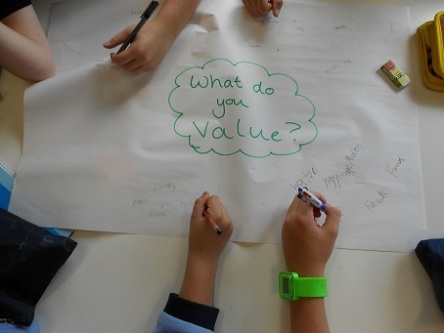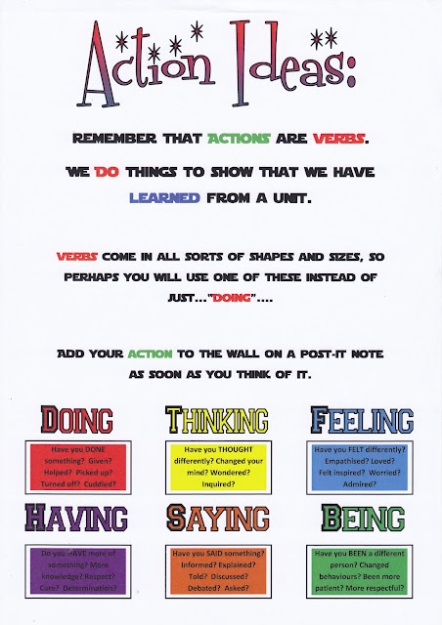I have a myriad of thoughts, ideas and wonderings that roam my mind all throughout the day. It’s an active place, with most of them appearing suddenly and often departing as quickly as they arrived. The ones that stick and become the most powerful are the ones that get a voice – sometimes that’s in the form of writing them down, while other times it is sharing them with a friend or colleague during discussion. It’s almost as if my mind is busy organizing my thoughts by importance and when given a voice, this automatically bumps them into the ‘let’s take some time and remember this’ category.
I look at many of my students now and see my past self in them – the ones who take their time to try to write neatly and make things look nice, the ones that love reading and writing and the ones that stay quiet during a discussion and never raise their hand. In my current school the majority are filled with confidence and vying for a voice, they can’t get enough attention and are eager for people to listen to their thoughts, but even there you find the quiet ones who often get dominated by others. They have many thoughts and wonderings running through their minds, but something in them holds them back. One of my major goals for this year has been to give everyone the space to have a voice. To create an environment where everyone takes the time to move their thoughts and wonderings into that place where they can be seen and heard. And by doing this, to value not only the thoughts but also the amazing people behind them.
In my journey, here are some things that I’ve found powerful.
Raising hands means you only get to hear from the quick thinking extroverts. Find other ways to draw out ideas and thoughts.
I’ve spent years having students raise their hands and having whole class discussions. I went to a PD last year and someone said the statement above, and it hit me how true it was. I was catering to extroverts, but not ALL of my students through hand raising class discussions. This rang so true because I knew that I had never raised my hand in school, yet I had many thoughts and ideas that probably would have enriched discussions. I still do have some class discussions with hand raising, and lately have been slipping back into them as I reflect on this – old habits die hard. A few methods that have started replacing these are:
- Sharing thoughts with the person next to you and in smaller groups rather than whole class and briefly drawing out key ideas, wonderings and thoughts gathered from walking around the room
- Silent Chalk Walks – where everyone has a pen that is their voice so no one is dominated
- Padlet.com and/or post-it notes – creating a padlet where everyone pops their thinking into one area and I can browse through it and notice/name things as well as question the students (or going with the old-fashioned post it notes as well).
- Using Google docs/sheets/slides – creating collective documents where they all add thinking and input and then can comment on each other’s thoughts and ideas.
- Using Google forms – everyone has input into whatever questions are asked and these can be brought up in future discussions – I often use these as ‘exit tickets’
- Using Todaysmeet.com – creating a backchannel when watching videos or doing other things so students can input thoughts, connections and questions.
Don’t expect immediate answers. Give thinking time.
One of the reasons I’ve never been a hand raiser is due to my introverted nature, but as I’ve overcome much of that shyness I’ve also learnt that I don’t think quickly – I need time to process and ponder and so do many of my students. In meetings, I’ll often now ask for more thinking time before I jump in because I’ve discovered that I need that time to ponder and sit with something. It’s taken me a long time to realize that. Things that have helped me to give more thinking time are:
- Putting a question up on the board or throwing it out there ahead of time (5 minutes, the night before – anything) before expecting answers. Giving time to ponder, connect, wonder and explore a thought before expecting students to weigh in on it.
- Taking time to have students write down/record what they think before sharing it with others.
- Having students go home and ask their family, friends, neighbours and other people about a big idea or question before adding their own ideas and thoughts.
- Asking, “Do you need more time to think about it?” and modeling that it is okay to need time to think by asking for it myself when talking with students.
Use thinking routines to help students learn how to structure and draw out their thinking.
There is so much power in learning how to structure your thinking, but it doesn’t come naturally to many. I have loved incorporating Harvard’s Thinking routines into my classroom and have also enjoyed creating my own versions to suit various purposes. Adding structure and giving visible and audible voice to thoughts has led to deeper thinking in our classroom. I’m still gradually experimenting with new ones all of the time, but some of my favourite include:
- Connect, Extend, Challenge
- See, Think, Wonder
- Claim, Support, Question
- Colour, Symbol, Image
- Tug of War
- 3-2-1 Bridge
- I Used to Think, Now I Think…
Make a point to notice and name good thinking from everyone. Help everyone to have a valued voice by making the thinking visible and audible.
There’s nothing I love more than when I notice an amazing thought, idea or wondering that a student has written that might not have been shared without being written or overheard and noticed. Every time they are captured and drawn out I feel that there is a strong message to that student that their ideas are powerful and valuable to those around them and are worth sharing.
In trying out different methods it hasn’t been perfect and there are still so many missed thoughts and ideas, but I feel like we’re making more space for everyone’s voice and there are many who are taking that opportunity to join in the thinking.







